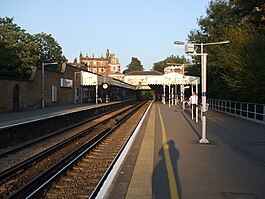This article needs additional citations for verification. (September 2007) |
| Blackheath | |
|---|---|
 | |
| Location | Blackheath |
| Local authority | London Borough of Lewisham |
| Managed by | Southeastern |
| Station code(s) | BKH |
| DfT category | C2 |
| Number of platforms | 2 |
| Accessible | Yes |
| Fare zone | 3 |
| National Rail annual entry and exit | |
| 2018–19 | |
| – interchange | |
| 2019–20 | |
| – interchange | |
| 2020–21 | |
| – interchange | |
| 2021–22 | |
| – interchange | |
| 2022–23 | |
| – interchange | |
| Key dates | |
| 30 July 1849 | Opened |
| Listed status | |
| Listed feature | Blackheath Railway Station |
| Listing grade | II |
| Entry number | 1358479[2] |
| Added to list | 12 March 1973 |
| Other information | |
| External links | |
| Coordinates | 51°27′57″N 0°00′32″E / 51.4658°N 0.0089°E |
Blackheath railway station is Grade II-listed and is in the south-centre of Blackheath, a village in southeast London. In traditional terms the area immediately south-west of the station around Lee Terrace and Lee Park is part of Lee;[3] a status challenged by the station's naming, buildings such as the Blackheath Halls and the development of Blackheath Park to the south east. It is 8 miles 52 chains (13.9 km) measured from London Victoria.
The tracks run through the village and are crossed by a road overbridge on which the station buildings stand.
- ^ a b c d e f g h i j "Estimates of station usage". Rail statistics. Office of Rail Regulation. Please note: Some methodology may vary year on year.
- ^ Historic England. "Blackheath Railway Station (1358479)". National Heritage List for England. Retrieved 8 June 2015.
- ^ https://www.achurchnearyou.com/search/?lat=51.463&lon=-0 St Margaret's, Lee, map of parish, Church of England, retrieved 2019-08-11.
